|
 Secure Site
Secure Site
|
 |
 Waking Gently
Waking up in the morning is a metaphor for life — a kind of daily microcosmic reenactment of our overall purpose for being in the world. That is, just about every religious tradition emphasizes spiritual growth. And the connection between “awakening” and spiritual growth can be found in practically all forms of spiritual teaching.
So if waking up in the morning really is a metaphor for our larger spiritual lives, this perspective might help us treat our morning ritual of getting out of bed as a kind of spiritual practice. Indeed, when approached in this way, how we wake up in the morning can make a larger difference in our lives overall.
Perhaps this is stretching the matter, but there are many people who do recognize that something as simple as waking up in the morning can be an authentic form of spiritual practice. For those who don’t have to go to work or get the kids to school, waking up naturally, whenever their body feels like it, can be a wonderful version of this practice. Waking up without an alarm, whenever your body has had enough rest, is probably the healthiest option, and the one that will leave us feeling most refreshed and ready to start the day. However, there are few of us that have this luxury, especially during the week.
Fortunately, for those who want to wake up right, without being startled awake by an annoying alarm or some radio DJ, there is The Zen Alarm Clock. This clock was designed to make waking up a kind of spiritual practice. The Zen Clock wakes users with a built-in 10 minute gradual progression of acoustic chimes. And this gradual form of “progressive awakening” has been thoughtfully designed to include esoteric features that are fitting for a form of spiritual practice. For example, not only is the hardwood Zen Alarm Clock beautiful to see and hear, the clock’s chime is tuned to produce the same frequencies as the tuning forks used by musical therapists in their healing work. Moreover, the Zen Clock’s pre-programmed 10 minute chime progression sequence advances according to the “golden ratio,” which reflects both the natural proportions of our own bodies and the patterns of growth used in the overall evolution of the universe.
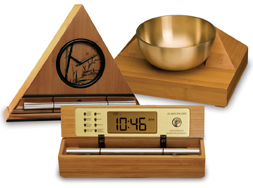 Family of Zen Alarm Clocks for a Peaceful Awakening
Now & Zen Clock Store
1638 Pearl Street
Boulder, CO 80302
(800) 779-6383
Posted in Bamboo Chime Clocks, Natural Awakening, sleep, Sleep Habits
 Yoga for Bedtime Need help sleeping? Doing yoga exercises before bedtime can be just what you need:
Sit up in bed comfortably, either with your legs folded or straight in front of you; whatever you can do with the most ease. Sit up and lean slightly back on your pillows or backboard. Close your eyes and rest your hands on your thighs and just breathe here for a few minutes. This doesn’t have to be a serious meditation but just a short while to do nothing but breathe.
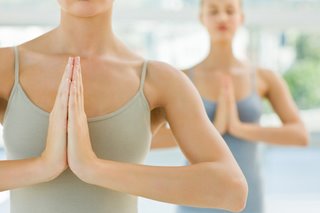 Yoga for Bedtime Use our unique “Zen Clock” which functions as a Yoga Timer. It features a long-resonating acoustic chime that brings your meditation or yoga session to a gradual close, preserving the environment of stillness while also acting as an effective time signal. Our Yoga Timer & Clock can be programmed to chime at the end of the meditation or yoga session or periodically throughout the session as a kind of sonic yantra. The beauty and functionality of the Zen Clock/Timer makes it a meditation tool that can actually help you “make time” for meditation in your life. Bring yourself back to balance.
adapted from Women’s Magazine by TARA STILES
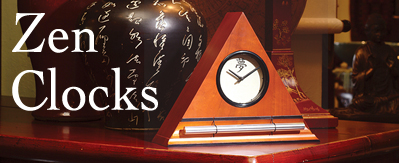 Yoga and Meditation Timers with Chimes and Gongs Now & Zen – The Yoga Timer Shop
1638 Pearl Street
Boulder, CO 80302
(800) 779-6383
Posted in Bamboo Chime Clocks
 The Ins and Outs of Better Breathing The ins and outs of better breathing
Try this relaxation exercise from breathing guru Andrew Weil, MD, best-selling author and clinical professor of medicine at the University of Arizona. The payoff? “Blessed relief” from constant thinking, Weil says.
- Sit with your back straight.
- Place the tip of your tongue against the ridge just behind your front teeth.
- Exhale completely through your mouth, making a whoosh sound.
- Inhale quietly through your nose with your mouth closed to a mental count of four. Hold your breath for a count of seven.
- Exhale completely through your mouth, this time whooshing to a count of eight.
- Inhale again and repeat the exercise three times for a total of four breaths.
 How to Improve Your Breathing
TIP: If you have trouble holding your breath, speed up but stick to the four-seven-eight count. Practice twice a day, but don’t do more than four breaths at a time for the first month; later you can work up to eight breaths. You may feel a little light-headed, Weil says, but it will pass.
Now & Zen – The Gong Meditation Timer Shop
1638 Pearl Street
Boulder, CO 80302
(800) 779-6383
 Set Your Gong Meditation Timers for a Breathing Exercise
Posted in Bamboo Chime Clocks
 Meditation and Yoga Researchers say they’ve taken a significant stride forward in understanding how relaxation techniques such as meditation, prayer and yoga improve health: by changing patterns of gene activity that affect how the body responds to stress.
The changes were seen both in long-term practitioners and in newer recruits, the scientists said.
“It’s not all in your head,” said Dr. Herbert Benson, president emeritus of the Benson-Henry Institute for Mind/Body Medicine at Massachusetts General Hospital and an associate professor of medicine at Harvard Medical School. “What we have found is that when you evoke the relaxation response, the very genes that are turned on or off by stress are turned the other way. The mind can actively turn on and turn off genes. The mind is not separated from the body.”
One outside expert agreed.
“It’s sort of like reverse thinking: If you can wreak havoc on yourself with lifestyle choices, for example, [in a way that] causes expression of latent genetic manifestations in the negative, then the reverse should hold true,” said Dr. Gerry Leisman, director of the F.R. Carrick Institute for Clinical Ergonomics, Rehabilitation and Applied Neuroscience at Leeds Metropolitan University in the U.K.
“Biology is not entirely our destiny, so while there are things that give us risk factors, there’s a lot of ‘wiggle’ in this,” added Leisman, who is also a professor at the University of Haifa in Israel. “This paper is pointing that there is a technique that allows us to play with the wiggle.”
 Meditation and Yoga Reduce Stress Benson, a pioneer in the field of mind-body medicine, is co-senior author of the new study, which is published in the journal PLoS One.
Benson first described the relaxation response 35 years ago. Mind-body approaches that elicit the response include meditation, repetitive prayer, yoga, tai chi, breathing exercises, progressive muscle relaxation, biofeedback, guided imagery and Qi Gong.
“Previously, we had noted that there were scores of diseases that could be treated by eliciting the relaxation response — everything from different kinds of pain, infertility, rheumatoid arthritis, insomnia,” Benson said.
He believes that this study is the first comprehensive look at how mind states can affect gene expression. It also focuses on gene activity in healthy individuals.
Benson and his colleagues compared gene-expression patterns in 19 long-term practitioners, 19 healthy controls and 20 newcomers who underwent eight weeks of relaxation-response training.
More than 2,200 genes were activated differently in the long-time practitioners relative to the controls and 1,561 genes in the short-timers compared to the long-time practitioners. Some 433 of the differently activated genes were shared among short-term and long-term practitioners.
Further genetic analysis revealed changes in cellular metabolism, response to oxidative stress and other processes in both short- and long-term practitioners. All of these processes may contribute to cellular damage stemming from chronic stress.
Another expert had a mixed response to the findings.
Robert Schwartz, director of the Texas A&M Health Science Center’s Institute of Biosciences and Technology in Houston, noted that the study was relatively small. He also wished that there had been more data on the levels of stress hormones within the control group, for comparison purposes.
However, Schwartz called the study “unique and very exciting. It demonstrates that all these techniques of relaxation response have a biofeedback mechanism that alters gene expression.”
He pointed out that the researchers looked at blood cells, which consist largely of immune cells. “You’re getting the response most probably in the immune cell population,” Schwartz said.
“We all are under stress and have many manifestations of that stress,” Benson added. “To adequately protect ourselves against stress, we should use an approach and a technique that we believe evokes the relaxation response 20 minutes, once a day.”
Use our unique “Zen Clock” which functions as a Yoga & Meditation Timer. It features a long-resonating acoustic chime that brings your meditation or yoga session to a gradual close, preserving the environment of stillness while also acting as an effective time signal. Our Yoga Timer & Clock can be programmed to chime at the end of the meditation or yoga session or periodically throughout the session as a kind of sonic yantra. The beauty and functionality of the Zen Clock/Timer makes it a meditation tool that can actually help you “make time” for meditation in your life. Bring yourself back to balance.
There’s more on meditation at the U.S. National Center for Complementary and Alternative Medicine.
 Yoga and Meditation Timers with Chime Now & Zen – The Yoga and Meditation Timer Shop
1638 Pearl Street
Boulder, CO 80302
(800) 779-6383
Posted in Meditation Timers, Meditation Tools, mindfulness practice
 eating in season Summer–for most of us it’s the season of fun, a time to get out of our homes and enjoy the sunlight. In addition to the bright summer days, many delicious and unique foods are in season.
By Brooke Holmgren
Foods eaten in season contain peak nutrients and generally put less of a dent in your budget than if purchased out of season. Whether you want to grow your own fresh produce in your backyard, stop by a farmers market, or shop at your local grocery or co-op, the following hints and tips lead you to the freshest produce and where to find it.
Summer Produce
First of all, to eat in season means choosing fruits and vegetables at their natural peak growing times. When produce is grown in conditions that require minimal care, they’re in season; think of how berries grow fat and ripen in the hot steamy months of July and August. Here is a list of commonly known produce best eaten in the summer months: basil, green beans, beets, all kinds of berries, bok choy, broccoli, cabbage, carrots,
celery, chicories, collard greens, cucumbers, fennels, arugula, all kinds of herbs,
lettuce, mustard greens, onions, peas, peppers, radicchio, spinach, summer squash, tomatillos, and tomatoes.
Some produce is best grown in your backyard, while others taste better left to the pros. So, which vegetables are best purchased fresh or picked from your yard?
The Joys of Gardening
There are several benefits to growing your own produce. For one, you know exactly what has been placed on or around the garden. This is the only certain way to know if your produce is organic or not. You’ll also have a greater appreciation for where your food comes from. Starting a garden from seeds or young plants is also much cheaper than buying produce from a grocery store. In addition, it’s fun to pick a cucumber or tomato from your back yard to include in your dinner. In this way, gardening tends to be a rewarding experience.
>>What to grow : While vegetable (and fruit) gardening varies by temperature zone (see garden.org/zipzone/to find your specific zone), there are a few staples that can be grown just about anywhere. These include tomatoes, cucumbers, spinach, and lettuce.
Berries grow best in moderate climates, especially in the northern United States, but citrus fruits are best grown in year round heat…think of Florida’s famous oranges.
>>What to do with too much produce: Sometimes your tomato plants offer up far too many tomatoes for you and your family to eat. Canning these vegetables preserves the taste and freshness throughout the year. How nice it would be to open a jar of tomatoes in
winter to include in a soup or stew!
>>The environmental benefits of gardening: In addition to the immediate cost benefits of gardening on your monthly grocery bill, the cost of gardening is also minimal on the environment. Consider those imported Chilean blueberries you can buy at the supermarket in January. Those blueberries were picked before they were fullyripened (drastically reducing vitamin and mineral contents) in order to ship them to your supermarket before spoiling. Thousands of gallons of fuel are consumed by tractors, trucks, and airplanes in order to get those blueberries to your table. The same is true for
most, if not all, fresh produce purchased during winter months if you live in northern climates. Of course it’s always beneficial to your health to eat fruits and veggies, but consider where these foods come from. The closer the food is grown, the better for your health, your wallet, and the environment.
Fresh Farmers Markets
Whether found in urban city centers with hundreds of vendors or a roadside stand with five farmers, there has been a recent farmers market revival due to the high quality of the food.
>>More bite for your buck: This rise in popularity is mainly due to the generous amount of food you get for your dollar. At a farmers market, you’re buying directly from the farmer or the farmer’s family, eliminating the markupfrom supermarkets and grocery stores. In addition, the foods purchased are fresh! Like foods picked from your garden when ripe, the produce sold at farmers markets are rarely picked prematurely. This ensures the best taste and nutrient value.
>>Fewer dents in the environment: Like gardening, the environmental impact of shopping for produce at a farmers market is much less than shopping at a conventional supermarket. However, some farmers and consumers may have to travel long distances to participate in a farmers market, especially urban markets. Regardless, shopping at a farmers market is a great way to ensure food quality and healthfulness.
>>Conecting with the farmer: At farmers markets you often purchase produce directly from the farmer and can speak to him or her about the food you’re buying. Knowing the person or people who grew your food can be a rewarding experience. It makes you feel more connected to the food you’re eating.
Farmers markets can also be a great place to socialize. What other place can you think of where urban dwellers and rural farmers mingle? There are often people from all walks of life depending on where the market is. Urban markets tend to be larger and feature more ethnically diverse foods.
>>Popular market eats: According to a 1998 study done by Rutgers University, the most popular foods purchased at farmers markets are apples, blueberries, broccoli, carrots, melons, peaches, peppers, snap beans, strawberries, sweet corn, and tomatoes. In addition to freshly grown food, there are often artesian-baked goods available. Other commonly available items are plants, flowers, jams/jellies, fresh fruit juices, dried fruits, cheese, organic meats, honey, farm fresh eggs, and nuts.
Again, there are seasonal aspects to farmers markets. Often times there are summer, fall, and winter markets featuring respective produce. Winter markets are likely to favor gourds, squash, sweet corn, and canned or preserved goods. Depending on what produce or goods you’re looking for, shop in season. Mid to late summer is the best time for abundant farmers
markets.
Boulder, Colorado—an innovative company has taken one of life’s most unpleasant experiences (being startled awake by your alarm clock early Monday morning), and transformed it into something to actually look forward to. “The Zen Alarm Clock,” uses soothing acoustic chimes that awaken users gently and gradually, making waking up a real pleasure.
What makes this gentle awakening experience so exquisite is the sound of the natural acoustic chime, which has been tuned to produce the same tones as the tuning forks used by musical therapists. According to the product’s inventor, Steve McIntosh, “once you experience this way of being gradually awakened with beautiful acoustic tones, no other alarm clock will ever do.”
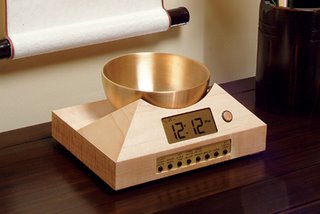 Maple Zen Timepiece Now & Zen – The Zen Alarm Clock Store
1638 Pearl St.
Boulder, CO 80302
(800) 779-6383
Posted in Bamboo Chime Clocks
 sleeping problems How to Fight Too Much Sleep
Not getting enough sleep can sometimes be a bad thing. But did you know that getting too much sleep is just as bad?
Set an alarm . It doesn’t have to be too early, just enough to get anywhere from 7-9 hours of sleep. Do this for at least a month and your body will get used to waking up at this time so you won’t have to use the alarm. Try not to hit to snooze button, however, it trains your body to stay tired in morning. If you have a coffee machine that will start at certain time automatically, set it so you can wake up to the scent of fresh brewed coffee.
Or just use an alarm clock that is not disruptive!
Fortunately, for those who want to wake up right, without being startled awake by an annoying alarm or some radio DJ, there is The Zen Alarm Clock. This clock was designed to make waking up a kind of spiritual practice. The Zen Clock wakes users with a built-in 10 minute gradual progression of acoustic chimes. And this gradual form of “progressive awakening” has been thoughtfully designed to include esoteric features that are fitting for a form of spiritual practice. For example, not only is the hardwood Zen Alarm Clock beautiful to see and hear, the clock’s chime is tuned to produce the same frequencies as the tuning forks used by musical therapists in their healing work. Moreover, the Zen Clock’s pre-programmed 10 minute chime progression sequence advances according to the “golden ratio,” which reflects both the natural proportions of our own bodies and the patterns of growth used in the overall evolution of the universe.
adapted from Wikihow.com
 Chime Alarm Clock for a Gradual Awakening Now & Zen’s Chime Alarm Clock Store
1638 Pearl Street
Boulder, CO 80302
(800) 779-6383
Posted in Bamboo Chime Clocks, Natural Awakening, Now & Zen Alarm Clocks, Progressive Awakening, sleep, Sleep Habits
 Take a Pose to Dose - Kitagawa Utamaro Ukiyoe by YukiSakuma Take a pose to the doze
“There’s a feedback loop between the muscles and the brain,” Dr. Naiman explains. “When you stretch and release tension, the brain relaxes too.” The deepest meditative state is known as “sleepless sleep.”
To get to a sleepful state, Dr. Khalsa finds the yoga Bridge pose especially useful. Lie on your back with knees bent at a 90-degree angle and your heels parallel, close to your butt. Lift your hips and arch up onto your shoulders. Lace your palms together underneath your body and press your arms into the floor or mat. Hold the posture while taking 10 to 15 long, slow breaths.
 Take a Pose to Doze Use our unique “Zen Clock” which functions as a Yoga & Meditation Timer. It features a long-resonating acoustic chime that brings your meditation or yoga session to a gradual close, preserving the environment of stillness while also acting as an effective time signal. Our Yoga Timer & Clock can be programmed to chime at the end of the meditation or yoga session or periodically throughout the session as a kind of sonic yantra. The beauty and functionality of the Zen Clock/Timer makes it a meditation tool that can actually help you “make time” for meditation in your life. Bring yourself back to balance.
adapted fro Women’s Health Magazine by BY LIESA GOINS
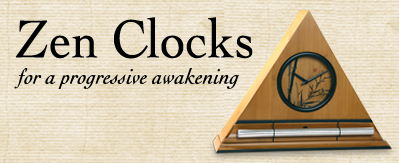 Waking up in the morning should be as pleasant as falling asleep at night. The Zen Alarm Clock's gradual, gentle awakening is transformative. Now & Zen – The Yoga & Meditation Timer Shop
1638 Pearl Street
Boulder, CO 80302
(800) 779-6383
Posted in Bamboo Chime Clocks
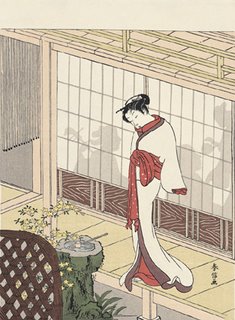 How to Ease Yourself to Sleep: Harunobu Suzuki, Beauty at the Veranda A big part of cognitive-behavioral therapy for insomnia is learning exercises to help your body relax before bed. One way to do this is through progressive tensing and relaxing of your muscles while lying in bed.
Has progressive muscle relaxation worked for you?
“Start at one end and work your way up or down your body,” says Joyce Walsleben, PhD, assistant professor at New York University School of Medicine. “Feel your muscles clench and then release, how they’re lying on the bed, how the covers fall over your body. Make it as elaborate or inconsequential as needed to put you into a cocoon of sleep.”
Another version of muscle relaxation: Imagine a wave of relaxation flowing down your body, from your head to your feet. You can give the wave a color, sound, or temperature.
“You should personalize the experience as much as you want,” says Kathy Doner, MD, who runs a hypnotherapy practice in Sebastian, Fla. “You might start by just noticing your breath with your hand on your tummy. Then with each out breath, focus on a different section of the body and say a word like ‘calm,’ ‘relax,’ or ‘peaceful,’ whatever works for you. You’re redirecting your attention to a part of the body, and when the mind is focused on the body, it’s not thinking ‘I can’t sleep.'”
To try progressive muscle relaxation tonight, follow these step-by-step instructions.
The body responds to stress with muscle tension, which can cause pain or discomfort. Progressive muscle relaxation reduces muscle tension and general mental anxiety. Progressive muscle relaxation often helps people get to sleep.
 Ease Yourself to Sleep Procedure
You can use a prerecorded audiotape to help you go through all the muscle groups, or you can just learn the order of muscle groups and work through them from memory.
- Choose a place where you can lie down on your back and stretch out comfortably, such as a carpeted floor.
- Inhale and tense each muscle group (hard but not to the point of cramping) for 4 to 10 seconds, then exhale and suddenly and completely relax the muscle group (do not relax it gradually). Give yourself 10 to 20 seconds to relax.
- When you are finished, return to alertness by counting backwards from 5 to 1.
Muscle groups and how to tense them
- Hands: Clench them.
- Wrists and forearms: Extend them and bend your hands back at the wrist.
- Biceps and upper arms: Clench your hands into fists, bend your arms at the elbows, and flex your biceps.
- Shoulders: Shrug them.
- Forehead: Wrinkle it into a deep frown.
- Around the eyes and bridge of the nose: Close your eyes as tightly as possible. (Remove contact lenses before beginning the exercise.)
- Cheeks and jaws: Smile as widely as you can.
- Around the mouth: Press your lips together tightly. (Check your facial area for tension.)
- Back of the neck: Press your head back hard.
- Front of the neck: Touch your chin to your chest. (Check your neck and head for tension.)
- Chest: Take a deep breath and hold it, then exhale.
- Back: Arch your back up and away from the floor.
- Stomach: Suck it into a tight knot. (Check your chest and stomach for tension.)
- Hips and buttocks: Press the buttocks together tightly.
- Thighs: Clench them hard.
- Lower legs: Point your toes toward your face, as if trying to bring the toes up to touch your head. Then point your toes away and curl them downward at the same time. (Check the area from your waist down for tension.)
 Ease Yourself to Sleep
Progressive muscle relaxation is sometimes combined with meditation.
adapted from Health.com by Healthwise
Boulder, Colorado—an innovative company has taken one of life’s most unpleasant experiences (being startled awake by your alarm clock early Monday morning), and transformed it into something to actually look forward to. “The Zen Alarm Clock,” uses soothing acoustic chimes that awaken users gently and gradually, making waking up a real pleasure. Rather than an artificial recorded sound played through a speaker, the Zen Clock features an alloy chime bar similar to a wind chime. When the clock’s alarm is triggered, its chime produces a long-resonating, beautiful acoustic tone reminiscent of a temple gong. Then, as the ring tone gradually fades away, the clock remains silent until it automatically strikes again three minutes later. The frequency of the chime strikes gradually increase over ten-minutes, eventually striking every five seconds, so they are guaranteed to wake up even the heaviest sleeper. This gentle, ten-minute “progressive awakening” leaves users feeling less groggy, and even helps with dream recall.
Now & Zen – The Progressive Chime Alarm Clock Shop
1638 Pearl Street
Boulder, CO 80302
(800) 779-6383
 Wake up refreshed, love your alarm clock, transform your mornings with The Zen Alarm Clock's progressive awakening with gentle chimes.
Posted in Bamboo Chime Clocks
 What is a Listening Meditation? Listening Meditation
What is it?
While many meditation techniques require solitude and silence, this one has you engage with sounds all around you; it invites you to work with the noise instead of fighting it. The intent is to experience sound as vibration, rather than information. “The listening practice is a way of interacting with the environment that allows you to take in the whole energy of the present moment,” says Sally Kempton, a spiritual guide who teaches yoga and meditation at her Carmel, Calif.- based Awakened Heart Meditation (sallykempton.com).
 What is a Listening Meditation Good For? What’s it good for?
Especially adaptable and portable, listening meditation can be practiced in crowded, noisy situations—on a bus, at the office—that would hinder other styles. (Kempton once led a listening meditation workshop in the middle of a busy Whole Foods store!) People with particularly chattering minds may need to couple this practice with a mantra or breathing meditation. However, many people welcome the chance to focus outward rather than inward and find that listening meditation is one of the easier techniques to undertake. “You’ll come away from it feeling refreshed, expanded and at ease with your environment,” declares Kempton.
How long does it take?
Try for five minutes at first, then continue adding a minute or two until you can do it for 15 or 20 minutes at a time.
How do I do it?
1. Sit in a comfortable position and close (or half close) your eyes.
2. To get centered and quiet, first go to your breath, noticing but not trying to change it.
3. Now “open” your ears and bring your awareness to the sounds around you. The goal is to listen to the whole range of sounds, without favoring one and without identifying them. Hear the quiet sounds and the silences as well as the dominant sounds.
4. When you find yourself identifying sounds (“there’s a fire engine”; “that’s my neighbor’s TV”), gently redirect your attention from listening to a specific noise back to hearing the whole spectrum of sounds.
5. To end, slowly open your eyes, stand and carry this awareness with you for as long as you can.
adapted from naturalhealthmag.com By Frances Lefkowitz
 Gong Meditation Timers for a Listening Meditation Now & Zen – The Gong Meditation Timer Shop
1638 Pearl Street
Boulder, CO 80302
(800) 779-6383
Posted in Meditation Timers, Meditation Tools, mindfulness practice
 Exercise to sleep better Exercise. If you have a sedentary job, a lack of physical exertion may be reducing the quality of your sleep. The human body uses sleep to repair and recover. If there isn’t much from which to recover, your body’s sleep cycle could be disrupted. A day of physical exertion (such as taking a run or a swim) or, better yet, regular exercise can make for deeper and more restful sleep. Don’t exercise right before bed to help you get to sleep; it tires out your muscles, boosts your heart rate, and makes you even wider awake.
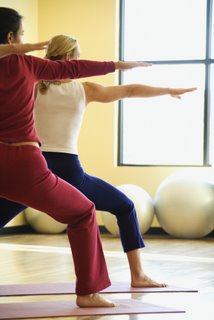 exercise contributes to better sleep Be sure to choose the best ‘Natural Awakening’ Alarm Clock made by Now & Zen, Inc. The Zen Clock features an alloy chime bar similar to a wind chime.
When the clock’s alarm is triggered, its chime produces a long-resonating, beautiful acoustic tone reminiscent of a temple gong. Then, as the ring tone gradually fades away, the clock remains silent until it automatically strikes again three minutes later. The frequency of the chime strikes gradually increase over ten-minutes, eventually striking every five seconds, so they are guaranteed to wake up even the heaviest sleeper. This gentle, ten-minute “progressive awakening” leaves users feeling less groggy, and even helps with dream recall.
 Natural Wake Up Alarm Clock Now & Zen’s Chime Alarm Clock Store
1638 Pearl Street
Boulder, CO 80302
(800) 779-6383
Posted in Uncategorized
|
|
|
|



























